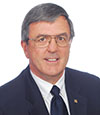Keynote Speakers (in alphabetical order)
| Dr. Nianzhi Jiao
Fellow, Chinese Academy of Sciences |
|
| [Speech] Why productive estuaries are sources rather than sinks of CO2?
Global change is the biggest environmental issue we are facing today. The ocean is the largest carbon sink on the earth, mitigating climate changes. The well-known biological mechanism for carbon sequestration in the ocean is the biological pump (BP). A newly recognized mechanism, the microbial carbon pump (MCP) is not only supplementary to BP but also provides new insights into a puzzling paradox: Why productive estuarine waters are often sources rather than sinks of CO2? Recent studies have showed that excess nutrients could facilitate the uptake of dissolved organic carbon (DOC) and enhance both bacterial production and respiration. Bacterial growth efficiency increases with increasing nitrogen concentration to certain levels but decreases thereafter, while the remaining DOC in the water usually decreases with increasing nitrogen concentration, suggesting that excess nitrogen could simulate uptake of DOC in the environment and thus have negative impacts on the DOC storage in the ocean. This is somehow against the case of the BP which is known to increase with increasing availability of nutrients. In addition to the direct negative effects of nutrients, another responsible factor is the nature of algal products. If it is labile, the organic carbon can not be preserved in the environment. On top of that, labile organic carbon has priming effects for river discharged semi-labile DOC for bacterial respiration. That is, labile organic matter will become the incubator for bacteria. While bacteria respire DOC into CO2, they consume oxygen, and finally cause hypoxia. Under anoxic condition, anaerobic bacteria successively work on the rest of the organic carbon and produce harmful gasses such as methane and H2S. Such story did have happened during geological events in the history of the earth. The above processes not only result in ecological disasters but also reduce the capacity of carbon sequestration in the ocean. In order to achieve maximum carbon sinks, both BP and MCP should be taken into consideration for management, especially in the coastal waters where eutrophication and hypoxia are severe. Currently, farm over-fertilization is found world widely to be responsible for coastal water eutrophication. Therefore nutrients input must be under control for optimum outputs of the sum of BP and MCP towards sustainable coastal ecosystems.
|
|
| Mr. Haseen Khan
Director of the Water Resources Management Division |
|
| [Speech] Application of Emerging Technologies in Water Resources Management
The Water Resources Management Division of the Department of Environment and Conservation has been exploring the application of emerging technologies in water resources management. In 2003, the Division introduced the Real-time Water Quality Monitoring Program in partnership with the industry. The program serves as an early warning system for emerging water quality issues associated with mining industry and other industrial mega-projects across the province.
Few selected innovative examples of applied work include the preparation of the first flood risk map in North America that looked at the effect of climate change and showed the extents of flooding due to climate change; the development and implementation of a unique and effective Hurricane Flood Alert System that helps communities in the province prepare for storms and avoid future high-cost expenditures in repairs and damages; and the development of world first operational space satellite based River Ice Monitoring Service, developed in cooperation with the European Space Agency and now used as an operational and climate change adaptation tool by several countries.
Finally, it provides an overview of a project in the Hashemite Kingdom of Jordan where our knowledge and expertise in the area of water resources management are shared through a cooperative project under the NATO Science for Peace and Security Program.
|
|
|
Director – Oceans & Atmosphere Flagship |
|
| [Speech] Impact Science: Multi-disciplinary Ocean and Atmospheric Scientific Research to Optimize Exploitation and Protection of Our Ocean Resources
Society benefits enormously from scientific research. In addition to deeper knowledge of our planet and universe, it provides us with new concepts and technologies that enable us to live longer and healthier. While every country has its own set of circumstances surrounding its level of wealth, research infrastructure, economic, environmental and developmental objectives; it is clear that issues such as the use of freshwater and marine resources and the production of energy sources, are complex and interconnected on a global scale. Research addressing these matters need to draw on expertise from physical and biological sciences as well as social sciences in a holistic approach.
CSIRO, Australia’s largest national research body, has established broad large-scale “pan-disciplinary” research groups known as Flagships to work on mission-directed research issues of national and global importance. Focus is given towards “monitoring progress towards impact” as opposed to “monitoring impact” to encourage flexibility among its scientists in their approach to achieve project goals. This paper will provide an overview of multidisciplinary science activities in CSIRO’s new “Oceans and Atmosphere” Flagship that has a challenge to define, monitor and protect the health and productivity of our oceans in the face of global climate change and coastal and offshore developments – that include an emphasis the assessment and mitigation of environmental risks associated with the recovery of offshore marine energy resources, and the development of improved marine emergency response capabilities and capacity.
|
|
| Dr. Donald S. Mavinic
Manning Foundation Laureate and Killam Scholar |
|
| [Speech] A Green and Sustainable Solution to Global Phosphorus Depletion
Resource recovery from different waste streams is now evolving as a necessary, sustainable development objective, driven by the urgent need to reduce consumption of vital natural resources(e.g. phosphate rock), reduce greenhouse gas emissions and conserve energy. A better understanding of the science, engineering and overall process integration is developing quickly. A new ‘paradigm’ in wastewater has emerged for nutrient removal and recovery, with particular emphasis on phosphorus. Dramatically shrinking global reserves of clean, economically recoverable phosphate rock are necessitating this paradigm shift. Commercial marketing of recoverable nutrients as ‘green fertilizers’ is now a reality. An overview of recent research, technology transfer and geo-political issues will be highlighted, including novel applications on the Canadian West Coast to rebuild salmon populations. |
|
Opening Speakers
| Dr. Ray Gosine
Professor and J.I. Clark Chair, Associate Vice-President (Research)
|
|
| Dr. Greg F. Naterer
Professor, Dean of Faculty of Engineering and Applied Science |
|
Lunch Speaker
| Mr. Dennis O’Keefe
Mayor of the City of St. John’s |







